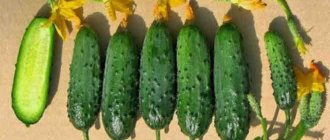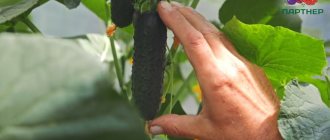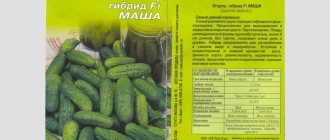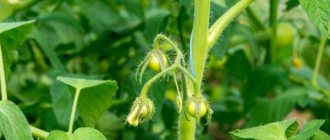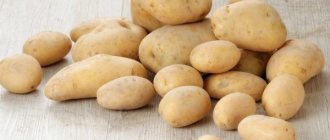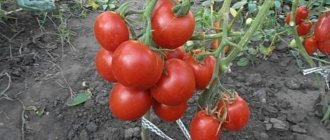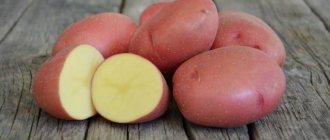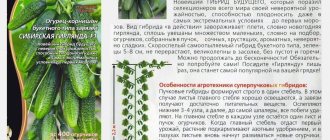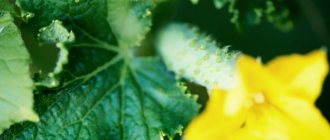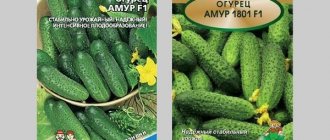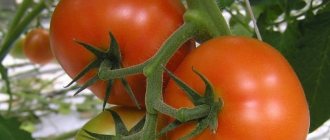The Mother-in-law F1 cucumber, despite its demanding nature and the need for regular care, has become popular in domestic gardens. This is due to the high taste and excellent presentation of the fruit, which ensures constant consumer interest in commercial sales.
Cucumbers of this variety are also good when used in the household. Fragrant fruits crunch loudly in summer salads. And the canned gifts of sunny summer will delight you with their dense pulp and impeccable shape.
History of the variety's creation
This hybrid was bred by breeders from the Russian breeding plant at the beginning of this century. After the tests, the variety was included in the State Register of Russia in 2007.
The authors and originators of the variety are the following specialists:
- A. E. Portyankin;
- S. F. Gavrish;
- A. V. Shamshina;
- V. N. Shevkunov.
The Tesha cucumber variety is zoned for cultivation in the following Russian regions:
- Central;
- Srednevolzhsky;
- Severny;
- North-West;
- North Caucasus;
- Central Black Earth;
- Volga-Vyatka.
Mother-in-law cucumber can be grown in open ground and in film greenhouses.
Cucumber Mother-in-law F1 - photo
Reviews from gardeners
The following is an overview of the opinions of amateur farmers about Mother-in-law F1 cucumbers.
Gennady, Voronezh: “ We spent a long time looking for cucumbers suitable for our greenhouse. We tried several, but chose the Mother-in-law F1. Simultaneous emergence of seedlings, rapid adaptation to greenhouse conditions, early ripening and good transportation are the main reasons that today we plant only Mother-in-Law F1.”
Victoria, Cherepovets: “The hybrid attracts me with its unpretentiousness and productivity. It is not a hassle to care for, but we do make sure to tie up the bushes (this makes it easier to harvest). Over 3 years of cultivation, a single aphid attack is the only problem.”
Svetlana, Krasnodar: “We planted Mother-in-law F1 last spring. The season was unsuccessful: rains, temperature changes, cold. But the chosen hybrid withstood all the difficulties perfectly and pleased us with a good harvest. There were enough greens for both food and pickling, although we only planted 15 bushes.”
Main characteristics and description of the cucumber variety Mother-in-law f1
Hybrid cucumber Mother-in-law is classified as an early-ripening variety
– from the moment of germination of crops until the first green crops begin to ripen, it can take up to 1.5 months. The Mother-in-law cucumber is classified as a parthenocarpic type; only female-type flowers are formed on the vines.
The lashes have good growth vigor, can reach a height of more than 1.5 m, the formation of lateral shoots is average. Foliage is formed on the stems in sufficient quantity; it is quite large and bright green in color.
Up to 4 ovaries can form in each sinus. The shape of ripe greens is cylindrical, gherkin type, length is up to 15 cm, weight of Mother-in-law cucumbers is 110-120 g
.
The diameter in cross section is no more than 4.0 cm. The skin is dense, crispy, covered with small tubercles and brown thorns. The pulp is dense, tasty, and has no voids.
On a note!
The main distinguishing feature of the Teshcha hybrid is the absence of bitterness in the fruits even when overripe.
The harvested crop can be transported to different distances, while the greens do not lose their beautiful appearance and taste. Ripe cucumbers can be stored in the refrigerator for quite a long time.
Mother-in-law cucumber greens are distinguished by their versatility of use - they are used for fresh consumption, in salads and snacks, canned, and salted.
The fruits tolerate heat treatment well, no voids are formed in them, and a slight crunch remains. For pickling and pickling, you can pick cucumbers at the gherkin stage.
Description and characteristics from the manufacturer of cucumber Mother-in-law F1
Cucumbers of this variety are characterized by increased resistance to heat and cold snaps.
Characteristics of the variety
Mother-in-law is an early-ripening hybrid variety that is valued by gardeners due to the lack of bitterness in green vegetables. Moreover, even overripe cucumbers do not have it. Since flowering is predominantly female, there is no need for insects for pollination.
The fruits are cylindrical in shape, their diameter is 4 cm, and their length is 11-13 cm. There are thorns and tubercles on the surface. The variety is high-yielding, and the first fruits can be collected within 45 days from the moment the seeds germinate. Plants are resistant to some diseases, one of which is powdery mildew.
Advantages and disadvantages of the Tesha variety in comparison with others
The main positive qualities of the cucumber hybrid Mother-in-law include:
- good taste of fruits;
- even overripe greens have no bitterness in their taste;
- the productivity of the Teshcha variety is above average;
- fruiting – extended;
- the versatility of ripe cucumbers;
- resistance to heat and cold;
- harvested cucumbers can easily withstand transportation over any distance;
- the versatility of ripened greens;
- increased resistance to powdery mildew.
Among the disadvantages, low resistance to downy mildew should be noted.
Reviews
Valeria, 43 years old, Cherepovets
When cucumbers with the funny names Zyatek and Mother-in-law appeared, we decided to try them. I liked both! We have now been planting in the greenhouse constantly for more than 5 years. For a good harvest, 10-15 bushes of each are enough for the whole family. Of course, they need to be constantly watered and fed well so that the plants have enough strength to produce a large number of fruits. Cucumbers taste great, sweet and juicy. I really like to crunch on a cucumber like this, plucked from a branch in the summer. For the winter, we mainly marinate Zyatek, while Mother-in-law is better when pickled.
Dmitry, 48 years old, Perm region
I don’t understand what’s special about Mother-in-law F1 cucumbers. I didn't like them at all. The cucumbers taste average, and the yield was also not impressive. There is no resistance to mosaic. With us they did not take root well and were sick for a long time.
Madina, 34 years old, Republic of Ingushetia
I recommend this variety to everyone. Tolerant of heat and cold, they bear fruit consistently in the open air. The bushes are very beautiful - flower bouquets first appear in the axils, and then cucumbers begin to develop in place of each flower. They are pimply, with non-spiny spines. All are nice and even, identical in color and size. For canning, I remove them while they are small so that they look better in jars. I collect every day. If you leave cucumbers on the vines for too long, they become thicker, but the peel and seeds do not become rough. These cucumbers taste excellent; bitterness does not appear even in heat and drought.
Pavel, 50 years old, Velsk
I can share my experience of growing “Mother-in-law F1” cucumbers. We started planting them about 3 years ago and have no plans to change them yet. We buy seeds only from, the germination rate is almost one hundred percent. Starting in April, we prepare the seedlings and plant them in a polycarbonate greenhouse by the end of May. As with all bunched cucumbers, it is important for Mother-in-law to form the bush correctly. We blind up to 4 leaves and pinch out all the lower stepsons so that a powerful root system has time to develop. We lead the plant into one stem, tie it and the upper side shoots to the trellis. We collect a large harvest throughout the summer. Each plant produces up to 500 cucumbers per season! Enough for food, homemade supplies and for sale. Cucumbers are very tasty, my mother-in-law approved!
Cucumber Mother-in-law: how to plant correctly
In most Russian regions, the Tesha cucumber hybrid is grown by seedlings. Soil for planting can be purchased in specialized stores, or you can prepare it yourself by mixing humus, peat and river sand in equal proportions. Wood ash is also added to this nutrient substrate.
Since cucumbers do not tolerate transplanting and picking well, seeds for seedlings should be immediately planted separately in plastic or peat cups.
Some vegetable growers plant Mother-in-law cucumber seeds in peat tablets, along with which the grown seedlings are planted in a permanent place.
During growth, seedlings need to be watered as the top layer of soil dries out; cucumber plants need to be fed a couple of times before transplanting into open ground. As the first feeding, you can use a urea solution. This fertilizer is applied when the cucumbers have their first true leaf. The second feeding is carried out approximately two weeks before transplanting the Mother-in-law cucumbers to a permanent place, or 10-12 days after transplanting.
This is interesting:
Growing cucumbers: care, fertilizing, watering, pinching and harvesting rules
12-14 days before transplanting cucumber seedlings Mother-in-law into open ground, you need to harden the seedlings.
To do this, first, containers with plants are taken out into the fresh air for an hour and a half, gradually increasing the time the seedlings stay. In the last days before transplanting, containers with seedlings should be left in the fresh air not only during the day, but also at night.
Mother-in-law cucumber seedlings are transplanted into open ground beds or greenhouses when at least 4 permanent leaves appear on them (usually this happens in late May - early June).
The place for planting cucumber seedlings is prepared in advance. In regions with a cool climate, it is recommended to prepare warm beds in which cucumbers will feel more comfortable.
Advice!
When preparing a plot for cucumbers, compost or humus should be added to digging in the fall (about 6 kg of organic matter for each square of area). In highly acidified soil, lime should also be added to deoxidize it.
If the groundwater on the site is located too close to the surface of the earth, then you need to prepare high beds with a drainage layer.
You need to add superphosphate and potassium salt to the prepared wells (15 g in each well). Cucumber seedlings in peat pots or tablets are planted in beds along with containers. And the seedlings are taken out of plastic cups along with a lump of earth, so as not to injure the delicate root system.
The distance between neighboring plants should be at least 50 cm, the distance between rows should be about 0.5 m.
After planting, Mother-in-law cucumbers are watered and, if necessary, covered with polyethylene to protect the tender seedlings from night frosts.
Growing seedlings yourself
In most of the Russian Federation, growing Tescha cucumbers involves pre-sowing them for seedlings, because sufficient soil heating is observed no earlier than the beginning or even the end of May. The specific timing of sowing seeds must be taken into account at home, as well as the requirements for preparing the substrate and the technology for placing planting material in prepared containers.
Optimal sowing dates
Sowing of cucumbers in seedling boxes is carried out about a month before planting in a permanent place of growth. The ideal age of young cucumber seedlings for transplanting them to the garden bed is considered to be 20–25 days from the moment of sowing the seedlings, that is, if it is planned for mid-May (the air temperature should reach +22...+28ºC during the day, and up to +18...+22ºC at night ), then sowing seeds can be done already in mid-April. A decrease in these values to +8ºC, which persists for more than two days, threatens the death of the plantings.
Read more about the timing of planting cucumber seedlings.
The soil
The ideal substrate for cucumber seedlings is light, nutritious soil with neutral acidity. You can buy such soil ready-made (sold in any gardening store) or prepare it yourself by mixing peat or leaf soil (1 bucket), sand (0.5 buckets) and ash (1 liter). Ash can be replaced with dolomite flour or lime, which is especially valuable when it comes to substrates with high acidity.
Also, do not forget that such a mixture will not contain any nutrients, which means you should add at least 3 tbsp to it. spoons of any complex fertilizer. In the future, during the growth of seedlings, instead of pure water for irrigation, each time you will have to use a mixture of liquid with complex fertilizers (must include potassium, phosphorus and nitrogen).
As an alternative, you can use a mixture of two parts turf soil, one part compost or peat and the same amount of sand (or perlite). When mixing all the ingredients, always try to get a homogeneous mixture, without any lumps.
Important! Before use, the finished purchased substrate must be disinfected by placing the bag with it in a bucket of very hot water (up to +70
°C
) with water.
Be sure to cover the bucket with a lid and leave the soil in this form until the water cools completely. You can also disinfect a self-prepared substrate by calcining it in the oven or spilling it with a weak solution of potassium permanganate.
Growing container
Almost any container is suitable for sowing cucumber seeds. This can be a small plastic box, separate plastic boxes or special cassettes with separate wells. Peat pots are also a good option for placing seeds, but they are not necessary. If seedlings have already been grown in a container before, then it should be scalded before reuse.
Seed preparation
Pre-planting preparation is needed not only for the soil, but also for the Tescha cucumber seeds themselves. Having selected only high-quality planting material (all seeds should be smooth and approximately the same size), it is immersed in a weak solution of potassium permanganate and left there for 30 minutes. After the specified time, all that remains is to rinse the seeds in clean water and dry them a little before sowing into the soil. Instead of potassium permanganate, you can also use special preventive drugs (for example, Fitosporin-M), which will help protect future seedlings from root rot and bacteriosis.
For rapid germination of planting material (especially in depleted soils), they are additionally soaked in solutions for root formation, such as Epin or Zircon, but for no less than 12 hours.
Sowing
The scheme for planting Tyosha cucumbers in seedling containers depends on the type of prepared container. For example, you can place 2-3 seeds in separate cups, deepening each of them 2-3 cm into the soil. When using boxes, sowing of planting material should be carried out taking into account the required distance between neighboring plants: at least 5 cm. The furrows are made at a distance of 10–15 cm from each other.
As for the technology for performing the process, it provides a standard set of landing actions:
- To begin with, the prepared soil is leveled and appropriate furrows are made in it, 3 cm deep.
- Then the soil is slightly moistened and the prepared seeds are placed in it, maintaining the required distance, according to the above scheme.
- At the end of the process, the cucumber seeds are covered with soil and the boxes are covered with glass or plastic film.
At the initial stages of cultivation, it is better to place seedlings in a dark place, with an air temperature not lower than +20ºC. After the young shoots appear, the boxes are transferred to a light windowsill and the film cover is removed.
Seedling care
For seedlings emerging from the ground, a sufficient level of lighting is an important condition for their normal growth and development. However, it is desirable that it be scattered, otherwise fragile sprouts may get burned. The first watering is usually carried out a few days after sowing the seeds, focusing on the condition of the soil: the dried top layer of the substrate is always slightly moistened so that a dense crust does not form on it. A few hours after adding the liquid, the soil in the boxes can be loosened, using for this purpose a small stick or even a match, deepened into the areas between the plants. It is better not to perform the procedure before the emergence of seedlings, since there is a high probability of getting the planted seeds out of the ground.
As for fertilizers, during the month of growing Tyosha cucumber seedlings, you can use complex mineral compounds twice, combining their application with the next watering of the plantings. Approximately 2–3 weeks after sowing, the grown plants can be planted from a common box into separate cups (dive). Very weak sprouts should be removed, leaving only strong and healthy specimens.
About a week before planting the grown seedlings in a permanent place of growth in open ground, they begin to harden them. In the first days, it is enough to take the boxes with seedlings to a closed balcony and leave them there for 1–2 hours, and after another 2–3 days, the time the seedlings stay in a cool place is increased to 4–5 hours. On warm days, the windows on the balcony can be opened, the main thing is to protect the cucumber seedlings from sudden gusts of cold air.
Did you know? The record for growing the longest cucumbers belongs to British pensioner Claire Pierce, who managed to grow a vegetable 119 cm long.
Further care for cucumbers Mother-in-law
Further care for Mother-in-law cucumbers includes watering, loosening the soil while simultaneously removing weeds, as well as fertilizing.
Mother-in-law cucumbers should be watered regularly, avoiding moisture stagnation in the soil.
Water for irrigation should be settled and warm. Watering with cold water can trigger the development of root rot in cucumbers. Watering is done at the root, trying to avoid splashes on the foliage - moisture on the leaves can cause downy mildew.
After watering the cucumbers, you can mulch the beds with peat or straw. This procedure helps prevent the rapid evaporation of moisture from the soil and the growth of weeds.
After the fruits begin to ripen, it is recommended to collect ripe Mother-in-law cucumbers every 2-3 days to allow new ovaries to develop.
It is recommended to tie the grown vines of the Mother-in-law cucumber to trellises - in this case, the plants are easier to care for and easier to harvest.
Advantages and disadvantages
The main advantages of the hybrid include:
- Ability to self-pollinate;
- Heat resistance and increased cold resistance;
- Excellent taste characteristics;
- High yield;
- Smooth yield of the harvest;
- Long fruiting period;
- High marketability of greens;
- No tendency to overripe and turn yellow;
- Unpretentiousness.
The disadvantage of "Mother-in-law" is the high cost of seed material.
How to feed cucumbers Mother-in-law
The Mother-in-law cucumber responds well to fertilization, especially from mid-August - in this case, side shoots appear on the vines, on which new ovaries appear.
Interesting!
Feeding cucumbers in the open ground with folk remedies for a good harvest
Feeding cucumbers
It is recommended to fertilize Mother-in-law cucumbers every 10-12 days, alternating organic matter and mineral fertilizers containing phosphorus and potassium. If at the beginning of the season ammonium nitrate or urea is usually used as a nitrogen-containing fertilizer, then in the summer it is better to use liquid organic fertilizers - infusion of mullein or bird droppings.
Agricultural technology or proper cultivation
Growing through seedlings:
- They begin sowing seeds for seedlings at the end of April;
- Seed material must be preheated to obtain the most vigorous germination. Afterwards, the seeds are disinfected in a manganese solution for 15-20 minutes;
- For cultivation you will need a container 10-12 cm high;
- A layer of drainage and a nutrient soil mixture are placed at the bottom of the container, which includes part of sawdust, 2 parts of humus and peat. For 10 kg of substrate add 30 g of nitrophoska and 40 g of wood ash;
- The seeds are buried 2 cm, then watered with warm water from a spray bottle;
- Cover with film until sprouts appear;
- At the stage of 3-4 full-fledged leaves, picking begins;
- Planted in a permanent place according to the recommended scheme - 50x50 cm.
Seedless method:
- Before sowing, prepare the soil. In April, the beds are dug up and fertilized with rotted manure;
- Planting holes are placed at intervals of 50 cm;
- Several seeds are placed in the holes and sprinkled with soil on top;
- Plantings are watered;
- At first, a temporary shelter is used;
- After the emergence of full-fledged shoots, the plantings should be thinned out, leaving only strong shoots.
Description and characteristics of Mother-in-law cucumbers
Mother-in-law is an early parthenocarpic hybrid created for growing under film covers. But this does not mean that cucumbers cannot be grown in open ground. In parthenocarpics, fruits are set without the participation of pollinating insects, which are also scarce in open ground now, especially in rainy summers. According to reviews from gardeners, the hybrid is resistant to adverse weather conditions, tolerates heat well, and then the heavy rainy season, while exhibiting high resistance to fungal diseases.
Parthenocarpic hybrids have a main long stem, so even in open ground they need to be grown on a trellis
Many varieties turn yellow from powdery mildew already at the beginning of the growing season, and Tescha bears fruit from early summer until autumn. High productivity is also due to the unlimited growth of the main cane. If you don't need a lot of cucumbers, you can pinch it at a comfortable height. Fruiting also occurs on the side shoots. 3–4 ovaries are formed in the axil of each leaf. The yield of one plant is 5–6 kg.
The first cucumbers can be harvested 44 days after germination. Their weight is 100–120 g, the skin is dark green with short blurry stripes, the spines are light, there are no seeds inside or they are poorly developed, the flesh is juicy and aromatic. The taste is rated as excellent. And another advantage of Tescha is its universal use; cucumbers are delicious fresh, in salads and in winter preparations. Jars of salted gherkins Mother-in-law do not explode and are stored until spring.
Mother-in-law can be recognized by the prickly thorns on the fruits; the cucumbers themselves are medium-sized, dark-colored
Growing cucumbers Mother-in-law
The technology for growing the variety differs little from the classical one. You need to select and prepare a site, grow seedlings or sow seeds directly into the ground. Then you have to carry out maintenance, which includes regular watering and fertilizing. Particular attention should be paid to the formation of the bush.
Site selection and soil preparation
If you plan to grow cucumbers in open ground, then choose a sunny place protected from the wind. As a backdrop on the north side, where the sun never shines, but cold winds blow, you can plant corn, sunflowers, peas, dill and other tall crops. By the way, these plants are good neighbors; you can also plant marigolds, radishes, beans, salads, and garlic nearby. The best predecessors for cucumbers are tomatoes, cabbage, corn, potatoes, and root vegetables. If you have a greenhouse, then try to swap crops there too. For cucumbers, select an area where they did not grow last year.
Corn is a good neighbor for cucumbers, but it needs to be planted on the shady side so that it does not block the sun for the cucumbers
Prepare the ground in advance. For each square meter of bed, scatter a bucket of humus and 200 g of wood ash and dig it up. Manure can be applied only 30–50 days before planting or in the fall at the rate of 9 kg (1 bucket) per 1 m². If there is no organic matter, then use the most affordable complex fertilizer - nitroammophoska (1 tbsp per 1 m²) or apply modern special fertilizers, for example, “Gumi-Omi cucumber-zucchini-melons” (0.7 kg per 5 m²).
Video: preparing space for cucumbers in a greenhouse using Finnish sausage technology
Dates for sowing seedlings and soil
Tyosha cucumbers are planted in open ground as seedlings or sown with seeds when the threat of frost has passed. In each region, the night temperature above zero is set at its own time, for example, in the middle zone at the end of May - beginning of June, in the northern regions 1-2 weeks later, in the southern regions - earlier. Seeds and seedlings can be planted under film cover and in a greenhouse 2 weeks before the onset of warm weather. Sowing seedlings should be done a month before this date, since the optimal age of young cucumbers for planting in a permanent place is 20–25 days.
Favorable temperature for cucumbers: during the day +22 ⁰C... +28 ⁰C, at night +18 ⁰C... +22 ⁰C. Plants die when the temperature drops to +8 ⁰C, which lasts more than two days, and at +5 ⁰C you will lose cucumbers in one day.
Seed preparation and sowing
Teschi seeds produced by the Gavrish company are colored, which means they are treated with growth stimulants, so they do not need to be soaked. Judging by the reviews of vegetable growers, cucumbers sprout very well.
Teschi seeds from Gavrish company are covered with a colored shell
If you bought this variety and the seeds inside the package are ordinary, without a colored shell, then keep them in a damp cloth and warm (not higher than +30 ⁰C) for 2-3 days. During this time, the seeds will hatch and you will be able to judge germination. Cucumbers do not like their roots being disturbed and they get very sick when transplanted, so plant each seed in a separate cup. When the time comes, transplant the cucumbers into the garden bed with a lump of earth.
The planting scheme for the Tyosha hybrid is 50x50 cm. It is valid for both cases: when you transplant seedlings, and when you sow seeds directly into the ground. Planting depth is 1–2 cm.
Video: how to grow cucumber seedlings
Watering and fertilizing
The roots of the cucumber are located in the upper, warmer layers at a depth of 20–25 cm from the surface. Without watering, this layer quickly dries out, the roots do not receive moisture, the leaves wither, the flowers and ovaries crumble. Therefore, from the moment of sowing and throughout the entire fruiting period, the soil in the garden bed should be constantly moist. Approximate water consumption is 10 liters per 1 m². You need to water every 1-2 days, maybe by leaves, but in such a way that they dry out before the onset of darkness and the cool of the night.
If you visit the site 1-2 times a week and cannot constantly monitor the soil moisture, then cover it with mulch of straw, hay or rotted sawdust. A layer of 5–10 cm will prevent moisture evaporation. You can arrange drip irrigation or stick upside down plastic bottles of water near the cucumbers.
Bottles of water are stuck into the ground, the cucumber itself will take moisture as needed
Mother-in-law is a very productive hybrid; throughout the warm season it actively grows leaves, shoots, flowers and fruits. There is a powerful removal of nutrients from the ground. What you put in when digging will only be enough for 1-2 weeks of the growing season. Therefore, every 7–10 days combine watering with fertilizing. Give the first: to seedlings - a week after planting; cucumbers sown in the ground with seeds - after the first flowers appear.
Feeding options for cucumbers:
- Green manure. Cover nettles or any weeds with succulent stems and leaves with water and let them ferment in a warm place for 7–10 days. Dilute the resulting slurry 1:5 with water.
- Mullein infusion. Dilute 1 part mullein (manure) in 5 parts water. Leave to ferment. After 5 days, dilute 1:10.
- Infusion of bird droppings. Prepare in the same way as mullein infusion, but for watering, dilute in a ratio of 1:20. This recipe is not suitable for store-bought litter. Read the instructions on the package.
- Yeast feeding. Dilute a packet of dry yeast in 3 liters of warm and sweetened water (2 tablespoons). Wait until foam appears, dilute with water to 10 liters and water. This type of fertilizing can only be given on warm soil; in cool weather the yeast will not work.
- Horse manure extract (available in stores). Dilute 1-2 caps in 10 liters of water.
- Special complex fertilizers for cucumbers brands: Agricola, Gumi-Omi, Bogatyr, BioHumus, etc.
- Wood ash. Shake 1 cup in a bucket of water and pour until the suspensions settle. Another option: water the leaves with clean water and dust them with ash.
Apply all these fertilizers on damp soil. They can also serve as foliar ones, that is, they can be poured onto the leaves. Apply foliar feeding in cool weather when the absorption capacity of the roots decreases. Be sure to alternate, do not constantly feed only manure or bird droppings. Nitrogen predominates in these fertilizers, and cucumbers need a complex of macro- and microelements. Next time, after fertilizing with organic matter, pour a solution of ash or a purchased mixture of microelements for cucumbers.
Video: 5 best fertilizers for cucumbers
Garter and shaping
As soon as the first tendrils appear on the young Tyosha cucumbers, stems with 5–6 leaves grow, tie them up. The easiest way in a greenhouse:
- lay metal pipes or fittings along the rows;
- take twine or other strong but soft rope;
- Tie one end to this pipe near the cucumber, and the other to the crossbar under the ceiling of the greenhouse.
Build a trellis in open ground; instead of twine, you can use a coarse mesh.
Trellis for cucumbers in open ground: ropes are stretched between the sides of the bed and the crossbar on top
Regularly twist the stems around the support clockwise. This is exactly how the sun moves across the sky, and all the plants follow it. If you leave cucumbers unattended, they will bend over and cling to neighboring ropes with their antennae. As a result, a continuous thick wall is formed, the flowers and ovaries inside it will be poorly lit and ventilated. You will lose in harvest.
Around the same period, begin to form bushes. Parthenocarpic Tescha grows in one stem, and its length is not limited. It will stretch and bear fruit as long as there is enough light, warmth, nutrition and water. Stepchildren are formed on the main stem; it is with their help that the yield can be regulated. If, for example, the trellis or greenhouse is low, and there is nowhere for the main vine to grow, then pinch it and leave all the stepsons. If you do not need a lot of cucumbers, on the contrary, remove all the stepsons and collect the fruits only from the stem.
Basic rules for the formation of parthenocarpic hybrids:
- The fruits are borne both on the main stem and on the stepsons. The longer the stem, the more stepsons, and the more space, light, water and nutrition the bush needs.
- Remove flowers, ovaries and stepsons in the axils of the lower 5 leaves. It has been experimentally proven that the ovaries formed higher grow faster than the lower ones. The very first (lowest) cucumbers always lag behind in development; the bush spends a lot of energy on them and stops its growth.
- If you leave stepchildren, then pinch them to a height of 1 m above the second leaf, at a height of 1 m to 1.5 m - above the 3-4 leaf, the topmost ones (at a level of 1.5-2 m) - above the 5-6 leaf.
- Throw the main lash, which has reached its maximum height, over the crossbar and let it grow down until the top drops to a level of 1 m above the ground. Another option is to pinch the cane under the ceiling of the greenhouse or above the crossbar of a trellis in the open ground.
As the bush grows, fruiting will go up. Remove the lower old leaves so that dirt does not accumulate on them and fungi do not settle.
Video: several ways to form cucumbers
Harvesting and processing
Mother-in-law is distinguished by the gradual return of the harvest. That is, you will collect the declared 5–6 kg per bush not in 1–2 times, but over the entire season. Cucumbers need to be picked from the bushes every 1–2 days. They can stay fresh in the refrigerator for 5-7 days, but to do this, first wash them and then wrap them wet in a plastic bag. Before canning, keep them in cold water for 8 hours, change them to fresh water every 2 hours. Cucumbers freshly picked from the garden can be pickled immediately.
Video: recipe for pickled cucumbers Mother-in-law and Son-in-law
Tescha cucumbers are famous for their excellent taste, they are crispy and aromatic. You can eat them fresh, prepare salads, pickle them and make them lightly salted. Okroshka is especially tasty with Mother-in-law, even in winter. Freeze the cucumbers whole, in winter, grate them directly in frozen form on a coarse grater and add to okroshka.
